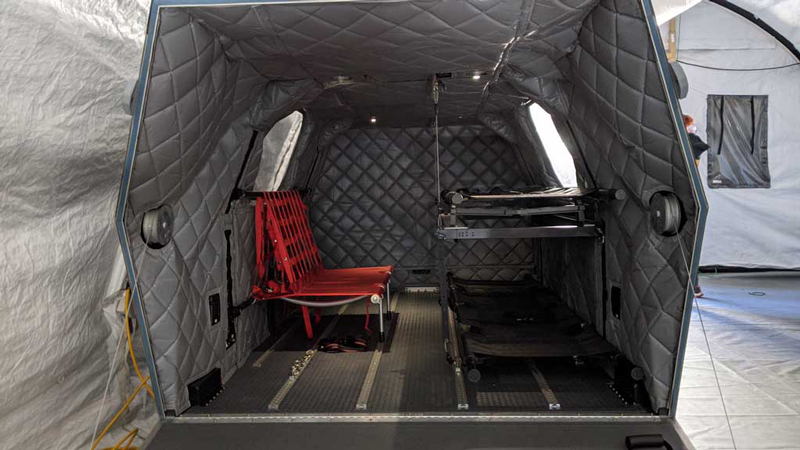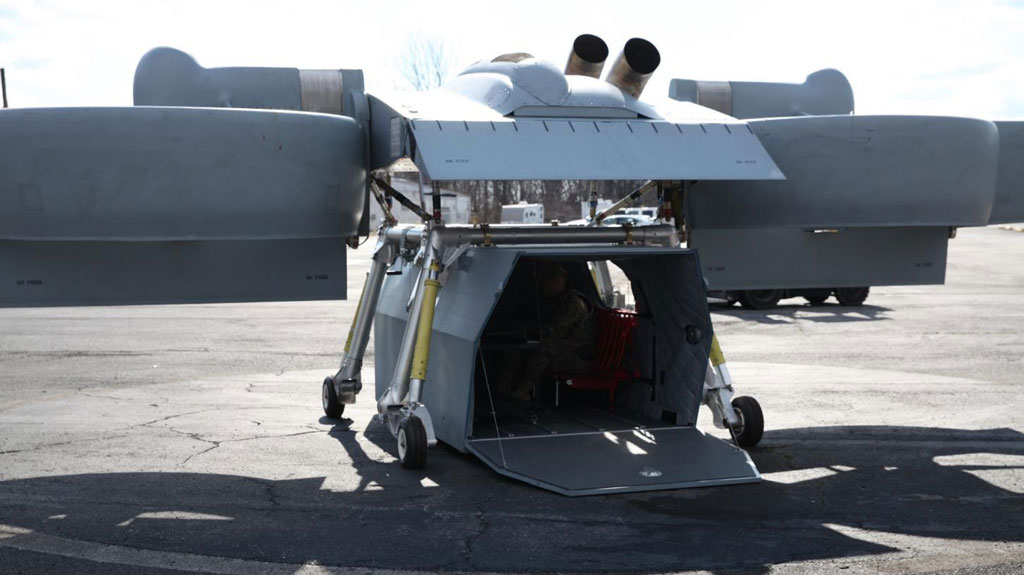MedRAS Engineers Introduce its Newest Research Asset, the M4
March 31, 2021 | Download PDF
TATRC’s Medical Robotics and Autonomous Systems (MedRAS) Division has a new resource and asset in its lab. In mid-March, the MedRAS team successfully took receipt of the prototype known as the Mobile Multiple Mission Module or ‘M4,’ at its location in Ft. Detrick. The M4, developed by our partners at Piasecki Aircraft Corporation, is a detachable transport module designed as a payload for the Aerial Reconfigurable Embedded System (ARES) Unmanned Aerial System (UAS). The ARES UAS is designed to support a variety of mission specific payloads. The M4 payload is multi-purpose, providing troop transport, cargo resupply, and patient evacuation.

The sleek, 12 ft. x 6 ft. aluminum housing may look a bit like an Airstream Travel Trailer, but TATRC is planning to use this prototype transportation pod for something much more critical than trips to the lake. While awaiting future flight tests onboard the ARES UAS, the M4 will be used as a transport simulator to support research for the next generation of advanced emergency casualty evacuation (CASEVAC) technologies.
The M4 will support an ongoing research effort that the MedRAS Lab is leading: the UAS Medical Research Platform (UMRP) project. This project’s goal is to design a testbed for early test and evaluation of concepts and technologies to support emergency CASEVAC operations, to expedite evacuation when traditional Medical Evacuation (MEDEVAC) assets are unavailable while retaining critical enroute care capabilities during transport. The M4 will be integral to this research testbed, which will be used to support research in physiologically-controlled closed-loop care systems, remotely-controllable medical devices, and next generation communications capabilities. This research ultimately will be used to design a remotely managed enroute care system onboard future vehicles of opportunity, such as future UAS. This system will support flight medics by decreasing manual workload and providing them telemedicine assistance during flight. As technology advances, this system may be able to replace the need for an onboard medic altogether in some cases.

Mr. Nate Fisher, Chief of the MedRAS Division, stated, “Having the M4 here on-site is a great asset to our MedRAS lab for our research efforts related to patient transport. The M4 will support early performance testing while it remains in our lab until it is needed next year for flight testing with the ARES UAS.”
The interior of the M4 is currently setup to support two medical litters for patient handling, as well as a bench seat for an onboard medic. However, the internal setup of the M4 can also be reconfigured to account for different operational needs. In addition, the pod is equipped with adjustable internal lighting and electronic connections for onboard medical and communications devices.

First year engineer Mr. Zachary Buono, who is working hands-on in support of the UMRP project, discussed some of the initial testing plans for the M4. “We are going to start by exploring how communications systems and remote controllability of our medical systems are impacted by being onboard the craft. We will also begin to determine how to develop these systems with the onboard user in mind. How can we effectively load the patient? How can we connect all necessary sensors and therapies? Those are the types of questions we hope to address. While this is a basic simulation, it will give us vital feedback before we begin airborne testing.”
For more information on this new and exciting resource, please contact Mr. Nate Fisher at nathan.t.fisher3.civ@mail.mil.
This article was published in the July 2021 issue of the TATRC Times.